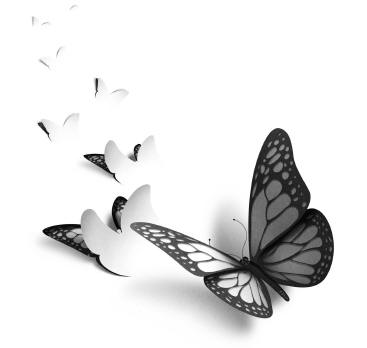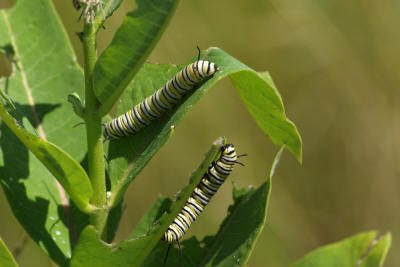Monarch Madness
Tim Iverson
Seasonal Naturalist
Cunningham Falls State Park
 (7/2013) This "king of the butterflies" is probably the most recognizable and archetypal butterfly around. When crafting a mental image of a butterfly chances are the first thing that pops into your head is the North American Monarch Butterfly. For good reason too! It has been one of the most
commonly occurring species for centuries, but that is quickly changing. They’re a hearty little insect that puts up one hell of a fight against all the curve balls that nature can throw its way by using some remarkable adaption’s. Even with these tricks up their proverbial sleeves they still have an uphill climb against declining populations.
(7/2013) This "king of the butterflies" is probably the most recognizable and archetypal butterfly around. When crafting a mental image of a butterfly chances are the first thing that pops into your head is the North American Monarch Butterfly. For good reason too! It has been one of the most
commonly occurring species for centuries, but that is quickly changing. They’re a hearty little insect that puts up one hell of a fight against all the curve balls that nature can throw its way by using some remarkable adaption’s. Even with these tricks up their proverbial sleeves they still have an uphill climb against declining populations.
As with any winged creature these guys are born to fly. In a single year these butterflies will migrate approximately 3,000 miles from Mexico to points North and East, and in some cases northeast. They’re the only insect that migrates these distances to escape the frigid winter months. Just like some of the older human population they move to milder
climates to ride out the winter and hibernate in peace. But not all Monarchs will do this, only the fourth generation in a given year will bound homeward on this incredible journey. With four separate stages these intrepid little insects will complete their life cycle.
 Every year Monarchs will arise from their winter slumber in Mexican fir forests around February or March. This generation will find and select a mate and begin their exodus back North seeking out places to lay their eggs. From March to April during this journey the Monarchs will lay their eggs
on milkweed plants. These eggs (the first stage of the Monarch life cycle) will hatch producing caterpillars (the second stage of the Monarch life cycle) in just a few days. Then they’ll spend about two weeks doing nothing but eating. The toxins in the milkweed plant build up inside these new caterpillars making them taste foul to potential predators, thus allowing them to
avoid getting eaten – which is something all life forms can aspire to. After about two weeks of pure gluttonous feasting the caterpillar is a full grown plump little bug. Finally being satiated the caterpillar will attach itself to the plant leaf or stem using silk and transform into a chrysalis (the third stage of the monarch life cycle). Inside that cocoon a whole lot of
change is going on, and in about 10 days the newly changed insect will emerge as a beautiful butterfly (the fourth and final life cycle stage). This Monarch will emerge with bright orange, black, and white colors that scream to potential predators "Hey! I taste really gross because I eat toxic plants, so don’t eat me!" and remarkably it works.
Every year Monarchs will arise from their winter slumber in Mexican fir forests around February or March. This generation will find and select a mate and begin their exodus back North seeking out places to lay their eggs. From March to April during this journey the Monarchs will lay their eggs
on milkweed plants. These eggs (the first stage of the Monarch life cycle) will hatch producing caterpillars (the second stage of the Monarch life cycle) in just a few days. Then they’ll spend about two weeks doing nothing but eating. The toxins in the milkweed plant build up inside these new caterpillars making them taste foul to potential predators, thus allowing them to
avoid getting eaten – which is something all life forms can aspire to. After about two weeks of pure gluttonous feasting the caterpillar is a full grown plump little bug. Finally being satiated the caterpillar will attach itself to the plant leaf or stem using silk and transform into a chrysalis (the third stage of the monarch life cycle). Inside that cocoon a whole lot of
change is going on, and in about 10 days the newly changed insect will emerge as a beautiful butterfly (the fourth and final life cycle stage). This Monarch will emerge with bright orange, black, and white colors that scream to potential predators "Hey! I taste really gross because I eat toxic plants, so don’t eat me!" and remarkably it works.
Once this new butterfly emerges from the chrysalis the process begins anew and this butterfly will spend the next six to eight weeks of its life migrating and propagating the species. There are only four generations in a given year, and the fourth and final generation will be born in September or October. This generation is different than the rest
though. Unlike the previous generations that die off after about two months this one can live for six to eight months. This generation is responsible for retracing the route south that their great-great grandparents followed north. They instinctively know to begin moving south when the weather begins to cool, and many even find the very same forests and trees that were used
by their very own progenitors.
For insect standards this bug is tough as nails. Despite being fairly hardy their once robust populations are dwindling. Monarchs historically covered approximately 50 acres worth of fir forests at wintering sites in Mexico. Based on recent research conducted for the 2011-2012 winter by the WWF-Telcel Alliance and the Mexican National Commission of
Protected Areas it appears a total of nine colonies occupied about seven acres of total forest. A similar study conducted over the 2012-2013 winter showed a sharp decrease of occupying just less than 3 acres of total forest. These are drastic decreases, and there are several factors contributing to these heavy losses.
For starters, several years’ worth of natural disasters along their migration routes and in their wintering sites has greatly reduced total population size. In addition, humans have done some meddling as well. Habitat loss from development and new farming techniques in certain regions of the US (I’m looking at you Midwest) have hampered stable
populations. The use of new genetically modified crops allows farmers to use new pesticides that have destroyed millions of acres of milkweed (the Monarch’s host plant) according to Chip Taylor, who leads the Monarch conservation group, Monarch Watch, based out of the University of Kansas.
Another obstacle facing the Monarch is the introduction of an invasive European plant, the Black Swallow-Wort. This plant is a relative of the milkweed, and has similar features which attract Monarchs to lay their eggs on this plant. However, even though it is in the same family it is actually toxic for monarch caterpillars and poison these newly
hatched larvae. While they do have a few predator birds that have learned to eat these butterflies, and a few specific parasites that attack them they wouldn’t have much of an impact on their own. Compounding these naturally occurring checks-and-balances with severe habitat destruction, the introduction of invasive plants, and severe weather and natural disasters the negative
effects have snowballed incredibly fast having drastic effects on the total population.
Of course, there are a few things the average person can do to help! Milkweed is the host plant for the Monarch butterfly and occurs naturally throughout the continent. Planting more of these in our area and yards will greatly increase the likelihood of regional success. Monarch Watch also hosts a sort of citizen scientist project that allows
interested people to sign up for population monitoring. They also provide tiny little stickers that are placed on the wings of the butterfly (when done correctly will not cause any harm or detriment to the bug). These stickers allow researchers in Mexico to see where these butterflies are migrating from, and they will update a website so you can see if your butterflies made
it all the way there! MonarchWatch.org has an incredible array of information on what you can do to help from creating "way-stations" for their spring and fall migrations, tagging resources, and more. I encourage anyone interested in helping rebound the population to look into planting milkweeds and check out the information and resources they offer.
While Monarch butterflies may be the king of the butterflies their throne is not so secure. Through events that are both in and out of our control they face an uncertain future. However, we all have a part to play in affecting what we can. Through some small tangible gestures we may be able to aid in the recovery of this once majestic quintessential
butterfly.